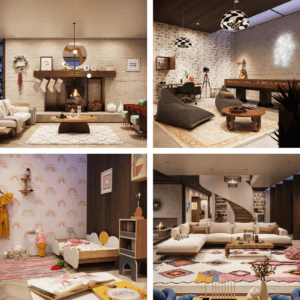Immersive realities have been a topic of frequent discussion in futuristic literature and dreamy conversations since the early 1960s. Today it is making a comeback, albeit this time manifesting itself in other areas of our daily lives. Virtual reality is a simulated experience that uses hardware and software to give the feeling of being immersed in a virtual world. Through the use of headsets, glasses, and other immersive wearable technologies, we can now even have tactile sensations. Meanwhile, augmented reality (AR) is a technology in which digital information and virtual objects are superimposed on the real environment to enhance the user’s perception and interaction with their surroundings. This technology (AR) uses sensors such as cameras, GPS, and accelerometers in devices like smartphones, tablets, and smart glasses to overlay digital information on the physical world. With the increasing digital marketing efforts of the world’s largest technology companies and the widespread availability of 5G technology, immersive realities and their associated technologies became more accessible. Everything else followed suit. Since then, companies have been keen to embrace these transformative technologies and explore the unprecedented opportunities that come with them.
The combination of virtual reality and augmented reality is an extremely powerful tool for businesses. Entrepreneurs and visionaries are aware of the potential of these technologies to simulate a wide range of real-world activities, such as marketing, finance, manufacturing, meetings, healthcare, etc. in virtual environments. This belief is not surprising, as we are already (for most) in the conversational phase of the metaverse. The influence of VR/AR is not confined to one area and will undoubtedly have a profound impact on several sectors in the coming years.
This article addresses the primary benefits of integrating VR/AR into business operations offers practical examples of how these technologies can be applied.

- Revolutionize the ‘Try Before You Buy’ Concept and how Gucci, L’Oréal and Volvo embraced this term. And get familiar with the project we developed for Galp.
- Immersive Corporate Training Experience and how surgeons and astronauts can now perfect their skills.
- Effective Prototyping as a major advantage for the aviation industry.
- Competitive Advantage: using VR/AR to stand out from the immense competition and provide a new experience to your clients. A new way to advertise and communicate your products or services.
1 – Revolutionize the ‘Try Before You Buy’ Concept
With the introduction of an enhanced “try before you buy” concept, companies can now completely transform the advertising industry and increase customer loyalty. By applying VR/AR technology, shopping experiences can be taken to a new level, resulting in increased brand engagement across both real and virtual platforms. With VR/AR, people can virtually “try on” products to ensure they meet their individual needs. This innovative approach applies not only to fashion and beauty retail, as exemplified by Gucci’s AR sneaker try-on and L’Oréal’s Makeup Genius virtual product testing, but also to other industries such as travel and automotive. Volvo’s VR test drive is a good example of the possibilities offered by this technology:
In addition to retail applications, companies are utilizing VR/AR technologies for industrial “try before you buy” purposes, leveraging simulation and preview tools to minimize operational costs. These tools can significantly reduce infrastructure construction costs by allowing engineers and contractors to virtually test and optimize designs before work begins. Here is our contribution to Galp’s gas tank measuring and visualization project, which helped our client ensure that all safety requirements were met prior to installation.
2 – Immersive Corporate Training Experience
Virtual and augmented realities are increasingly utilized as effective tools for delivering immersive training to both employees and customers. In this case, they are very useful for training activities that are challenging from a security perspective, which can be highly costly in the long run. Virtual reality gives you a safe and cost-effective platform for simulating dangerous scenarios without the high costs associated with traditional training methods. Imagine how beneficial this would be for a team that needs to train underwater welders, for surgeons who need to make life-and-death decisions during complex operations, or for Boeing when training astronauts.
New tools and procedures can be tried out in a safe and controlled space for the workers to train and gain the necessary skills for the real-world.
3 – Effective Prototyping
These technologies can revolutionize your company’s prototyping process, allowing you to visualize and design products with unparalleled precision. They enable a more precise product design process and a more accurate analysis of the product’s functionality. Using VR/AR can also be an effective way to identify design issues and make changes during the design process to avoid post-production complications. Companies such as Airbus and Boeing are using VR and AR technologies to design, test and validate new aircraft interiors, cockpits and other systems before they are manufactured. This allows their designers to evaluate cabin ergonomics, comfort, and functionality from the perspective of passengers and crew, and make the necessary adjustments to ensure maximum comfort and efficiency. These use cases demonstrate how VR and AR technology can improve the design and development processes, while reducing costs and increasing efficiency.
A successful prototype prevents us from wasting the resources available to us.
4 – Competitive Advantage
Immersive technologies give your company a competitive edge over your competitors.
Thus, if you want to stand out from your competitors, you should incorporate VR/AR as soon as possible. In today’s highly competitive market, marketers and entrepreneurs are constantly fighting to capture the attention of their audience, which can be challenging due to the saturation of the market. Traditional advertising is gradually declining with the emergence of new technologies. Exciting ads that encourage engagement are more likely to turn prospects into customers, and that’s exactly what virtual and augmented reality can provide. VR/AR offers a new way to showcase your products or services. Instead of visiting a physical showroom, customers who lead increasingly digital lives can simply put on a headset and appear in a virtual space, as it happens in Etsy’s Virtual House, which allows shoppers to “walk through” a digital house full with curated Etsy items.

This way you can increase your brand awareness, build a closer relationship with your customers and increase your sales.
In conclusion?
The motto “time is money” has never been more relevant than in the age of immersive technology, which offers the dual benefit of saving both. Some proponents argue that this technology can do everything faster and better than we can because it gives us what we currently strive for: Speed. Routine tasks can now be to your advantage, but you need to be able to look at it with an open mind.
It’s clear that both VR and AR (and all underlying technologies) will continue to evolve and bring real-world experiences into the digital world. This presents numerous opportunities for businesses, but it is still uncertain how the human brain will cope with all the recent breakthroughs. In addition, VR equipment is still very expensive for the vast majority of the population, leaving the disadvantaged excluded from these technological advances. Clearly, this discussion should be held regularly until we are able to reach a perfect balance.
Share your VR /AR challenge with us! Follow us on our social media and join the discussion.














